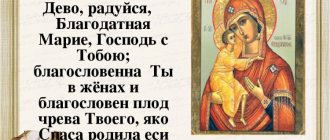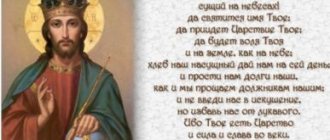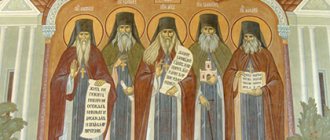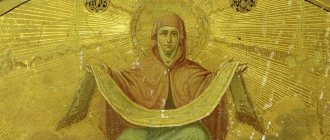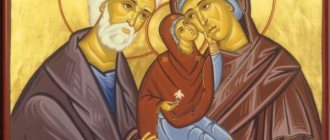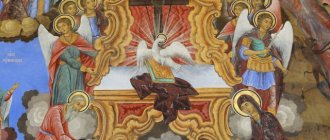For many hundreds of years, humanity has known a fairly large number of different prayers that can create a real miracle. The Hail Mary prayer falls into this category. The words spoken in this prayer can instill peace and faith in success into people’s souls.
About the author About the book
Virgin Mary, rejoice
Virgin Mary, Hail, blessed Mary, the Lord is with you, blessed are you among women and blessed is the fruit of your womb, for you have given birth to the Savior of our souls.
Translation
Mother of God Virgin Mary, filled with the grace of God, rejoice! The Lord is with You; Blessed are You among women and blessed is the Fruit born of You, because You gave birth to the Savior of our souls.
- The Mother of God is the one who gave birth to God.
- The words Hail, the Lord is with You, blessed are You among women, taken from the greeting of the Archangel Gabriel, when he announced to the Blessed Virgin Mary the birth from Her according to the flesh of the Son of God (Luke 1:28).
- The words Blessed are You among women mean that the Most Holy Virgin Mary, as the Mother of God, is glorified more than all other wives (Luke 1:42; Ps. 44:18).
- Graceful - full of grace, mercy from God.
- Blessed - glorified.
- The words blessed is the fruit of your womb taken from the greeting of the righteous Elizabeth, when the Holy Virgin Mary, after the Annunciation, wished to visit her (Luke 1:42). The fruit of Her womb is the Son of God Jesus Christ.
Story
The prayer is based on the greeting of the Archangel Gabriel to the Virgin Mary at the moment of the Annunciation (Luke 1:28-31; Matt. 1:18-25). The famous “Ave, Maria” is the same prayer in Latin.
^ To my Queen, Offering
My Most Blessed Queen, My Hope, Mother of God, Friend of the Orphan and Strange to the Representative, the Sorrowful to Joy, the Offended to the Patroness! See my misfortune, see my sorrow; Help me, for I am weak; feed me, for I am strange! Resolve my grievance, as if I were wrong: for I have no other help than You, no other Representative, no good Comforter, except You, O Mother of God! May you protect me and protect me forever and ever. Amen.
* * *
Translation: My Blessed Queen, My Hope, Mother of God, Shelter of orphans and wanderers, Protector, Joy of the grieving, Protector of the offended! You see my misfortune, you see my sorrow; help me as a weak person, guide me as a stranger. You know my offense: resolve it according to Your will. For I have no other help than You, no other Protector, no good Comforter - only You, O Mother of God: may you preserve me and protect me forever and ever. Amen.
Audio:
When and how to read the prayer “Virgin Mother of God, rejoice”
The prayer “Virgin Mother of God, rejoice” is included in the liturgy (morning service) and the evening troparion, where it is solemnly performed three times. The complete Theotokos rule is to read the prayer “Virgin Mother of God, rejoice” 150 times a day.
While reading every ten prayers, one must remember an event from the life of the Mother of God, the Queen of Heaven:
- 1. Birth of the Virgin Mary.
- 2. Entry into the Temple of the Virgin Mary.
- 3. Annunciation. Meeting with the angel Gabriel.
- 4. Date with Elizabeth.
- 5. Birth of Jesus Christ.
- 6. Presentation of the Lord.
- 7. Flight from Herod.
- 8. The disappearance of the Son in Jerusalem. Experiences of the Virgin Mary.
- 9. A miracle when, at the request of the Mother of God, Jesus turned water into wine.
- 10. Crucifixion of Jesus Christ. The Suffering of the Virgin Mary.
- 11. Resurrection of the Savior.
- 12. The Ascension of the Son of God, which was seen by the Mother of God, the Queen of Heaven.
- 13. The appearance of the Holy Spirit to the apostles and the Virgin Mary.
- 14. Death of the Mother of God.
- 15. Glory to the Virgin Mary in heaven.
After ten prayers, “Virgin Mother of God, Rejoice,” you should read the “Our Father” and the prayer “Merciful Doors.” To begin with, it is recommended to read forty times a day. Saint Seraphim of Sarov suggested, in the absence of free time, to read “Our Father” 3 times, “Virgin Mother of God, Rejoice” 3 times and “Creed” 1 time.
It is better to read the prayer “Virgin Mother of God, rejoice” in front of the icon of the Mother of God. The prayer is short and can be read, if necessary, at any time and in any place, most importantly with faith, with all your soul, thoughtfully.
What requests are made to the Mother of God in the prayer “Virgin Mother of God, rejoice”
The prayer is read if:
- yourself or your loved ones are sick;
- parents pray for their children;
- if you need the mercy of Jesus Christ, the prayer “Virgin Mother of God, rejoice” will also help;
- it is necessary to improve relations with relatives;
- pray for the missing;
- melancholy sets in;
- sinful or overcome by sinful thoughts;
- need help with business and relief from need;
- if it is unclear what to do, the prayer “Virgin Mother of God, rejoice” will help you make the right choice;
- for the marriage of girls;
- travel;
- you need to protect your family and home from evil and deceit;
- asking for a peaceful, serene death;
- food must be sanctified.
When you pray for others, ask the Queen of Heaven about this with prayer:
Most Holy Theotokos, accept the prayers from me of the sinful servant (name) for the servant of God (name), which are offered to You and grant him (specify request).
If necessary, change the masculine gender to the feminine gender in prayer.
^ Kontakion to the Selected Voivode
To the chosen Voivode, victorious, for having got rid of the evil ones, let us write thanks to You, Your servants, to the Mother of God: but as You have an invincible power, free us from all troubles, and let us call You: Rejoice Bride of No Bride Naya.
* * *
Translation: To You, the Supreme Commander, having been delivered from troubles, we, Your unworthy servants, Mother of God, sing a song of victory and gratitude. You, who have invincible power, free us from all troubles, so that we cry to You: Rejoice, Bride, who has not entered into marriage!
History: This kontakion to the Mother of God was compiled in honor of the deliverance of Constantinople in 626 from the invasion of barbarians, when Patriarch Sergius I of Constantinople walked around the city walls with an icon of the Mother of God and the danger was averted.
Audio:
History of the spread of prayer
This prayer appeared in the first centuries of Christianity. The “Angel's Message” gained popularity starting in the 5th century, after the Third Ecumenical Council. It began to be used everywhere in sermons, hymns and everywhere where the Virgin Mary was praised.
For example, the Romans customarily sing AveMaria, translated. "Hail Mary."
All Orthodox Christians, regardless of their denomination, pray to the Mother of God. But the residents of our country have a special relationship with the Mother of God, since she repeatedly helped save the country from enemies.
Later the prayer entered the divine service as a troparion. At Matins the prayer is read three times. It is included in both the morning and evening rules, without any restrictions. Let us recall that Seraphim of Sarov himself argued: if it is difficult for a believer to completely master the rule, then he can take a simpler path:
- “Our Father” - three times.
- “Rejoice, Virgin Mary” - three times.
- “Creed” – once.
He also advised reading “Theotokos...” before lunch, and after another prayer - “Lord, have mercy on me, a sinner.”
^ Oh, glorious miracle
Oh, glorious miracle! The Queen of heaven and earth, implored by our holy relatives, to this day covers the Russian land and mercifully enriches the image of Her face. O Lady Sovereign! Do not stop pouring out mercy and miracles for ever in order to establish Orthodoxy in Russia. Amen.
* * *
Translation: Oh, glorious miracle! The Queen of heaven and earth, to whom our holy relatives pray, still covers the Russian land and compassionately enriches it with Her images. O Sovereign Lady! Do not stop in the future to establish Orthodoxy in Rus' and pour out mercy and miracles until the century. Amen.
Audio:
Interpretation of the prayer “Rejoice, Virgin Mary”
The essence of this powerful prayer is to help all humanity, the earthly ministry of the Mother of God is the birth of the Savior, who in the future atoned for all human sins. Sincerity and true faith in the Lord God is what will save the human soul.
Now let's proceed to the direct interpretation of the prayer, in which each word has a specific meaning.
- “Theotokos” – Virgin Mary, Mother of God.
- “Rejoice” is a greeting. Now, when we greet each other, say “Hello”, we wish you health. At that time, when people greeted each other, they said “Rejoice,” that is, they wished each other joy.
- “Graceful” is an epithet that means you have been given grace.
- “Blessed are you among wives” - what does it mean in wives? A wife is a woman. This applies to all females, regardless of whether she is married or not. In Church Slavonic it sounds exactly like this. In Russian, we sometimes also say “learned” men. That is, we use the term “husband” not to mean that it is a marital state, but to mean that it is a man.
- “Blessed” - people will bless, praise, and turn to you. “Blessed are you among women” - why All because she gave birth to the Savior of our souls.
- “And blessed is the fruit of your womb” is not an angelic greeting, but words from another place in Holy Scripture. The fact is that the Virgin Mary, after a conversation with the Angel, went to visit her relative Elizabeth, who was also pregnant. She carried in her womb the future prophet John the Baptist.
Having met the Virgin Mary, she was filled with the grace of God and uttered these prophetic words.
- “Fruit of the womb” is our Lord Jesus Christ. God became a man in her, in her womb. The Lord is not material, God is Spirit. But he wanted to incarnate, materialize, take on human nature - to unite the Divine nature and the human into one person, into one hypostasis.
That is why she is called the Mother of God. That is, she gave birth to God. It is not that God did not exist before this birth. He always existed, created this world, but through her he took on human nature.
- Therefore, at the beginning of the prayer she is called “Mother of God . And “Virgin” because she gave birth to no one else except Jesus Christ. Mentioned in the Gospel as brothers and sisters of Jesus Christ are the brothers and sisters of Joseph the Betrothed from his first marriage, who was, as it were, the earthly father of Jesus. In his old age, Joseph was a widower.
The text of the prayer “Virgin Mother of God, rejoice” in Russian is in any prayer book. To read the prayer correctly, take a closer look at how the accents are placed. It is also read in Church Slavonic.
The cult of the Virgin Mary in Christianity
The role of the Mother of God was determined by the first gospels. She was called the Blessed One, “Blessed are you among women,” that is, the Lord honored her with the honor of bearing him a son among many women. “For you gave birth to Christ the Savior, the Redeemer of our souls” - the woman who gave the Savior to the world. Why her?
Because even before her birth she was predestined for this holy role. The Mother of God remained a virgin forever.
In Orthodoxy, about 300 holidays are associated with the Mother of God. Temples are erected in her honor. In Catholicism, among the saints, the Mother of God is highest. She is revered on a par with Jesus Christ.
How does prayer help?
Christians sincerely believe that it allows them to cope with various problems in life. “Theotokos...” is read in the following situations:
- in sadness and grief;
- to strengthen faith;
- before eating;
- in desperation;
- driving out evil forces;
- on a difficult and long road.
To achieve what you want, you need to read the sacred lines, adhering to some rules:
- The text must be repeated 150 times a day, taking the rosary (as a talisman, and they will also help you not to lose count).
- Words must be pronounced thoughtfully, understanding the meaning of each of them.
^ Angel crying
(honor of Easter)
The angel cried out with more grace: Pure Virgin, rejoice! And again I say: Rejoice! Your Son has risen three days from the grave, and raised the dead: people, rejoice. Shine, shine, new Jerusalem, for the glory of the Lord has risen upon you. Rejoice now and be glad, O Zion. You, Pure One, rejoice, O Mother of God, about the rise of Your Nativity.
* * *
Translation: The angel proclaimed to the Blessed One: “Pure Virgin, rejoice! And I will say again: Rejoice! Your Son rose on the third day from the grave and raised the dead.” People, rejoice! Shine, shine, new Jerusalem (New Testament Church) - the glory of the Lord has risen above you! Rejoice now and show off, O Zion! Rejoice, Pure Mother of God, about the resurrection of the One born of You.
Audio:
Why is the Mother of God depicted differently on icons?
Any icon carries symbolism, and in the icons of the Mother of God it is the deepest. Because the Mother of God is a man, but she holds the God-Man in her arms. God became a man, he came to people. This reflects the meeting of humanity in the person of the Mother of God and God in the person of our Lord Jesus Christ.
Very often, icons of the Mother of God depict the Mother of God hugging Jesus, or him clinging to her. This is all a symbol of God’s love for the human race and how people respond to this love to the Lord.
This relationship between mother and child contains very deep symbolism. That is why there are so many icons of the Mother of God, and they differ in writing. Icon painters put into their creations a certain aspect of the relationship between God and people. For example, there is a very beautiful Vladimir icon. It belongs to the iconographic work “Tenderness”.
Icons of this type emphasize tenderness, a feeling of love between God and people, between the Savior and the Mother of God.
In these icons, he hugs her and presses against her (with his cheek against her cheek). She holds it tenderly and points at it with her hand. The Mother of God looks at the person praying from the icon or at Jesus Christ, showing that he is the Savior.
In addition to the edition “Tenderness”, there is an edition “Hodegetria” (Greek: Guidebook). For example, the Kazan Icon of the Mother of God belongs to this version. In this icon, the Mother of God simply points her hand to the Savior, who says: “I am the way of true life.” The Most Holy Theotokos is depicted from the shoulders up.
There is also an edition of “Oranta” (Greek: Praying), in which the Mother of God is depicted in a prayerful pose with raised hands or holding a veil. That is, the Mother of God is depicted praying for the human race.
All icons contain symbolism, but in the case of the icons of the Mother of God there is a lot of it, which is why there is such a variety of Mother of God icons.
^ Oh, All-Singing Mother
(kontakion 13 Akathist to the Mother of God)
Oh, All-Singing Mother, who gave birth to all the saints, the Most Holy Word! Having accepted this present offering, deliver everyone from all misfortune, and from future torment, those who cry out for You: Alleluia.
* * *
Translation: “O all-sung (i.e., sung by all) Mother, who gave birth to the Word, the holiest of all saints! Having accepted the present offering (i.e., this prayer - akathist singing), deliver from all misfortune and remove from future torment everyone who exclaims to You: Alleluia.
Audio:
Theotokos rule
The Most Holy Virgin Mary bequeathed to us the Rule of the Theotokos. At first Christians adhered to it, but over time everything changed. Fortunately, he was revived by Bishop Seraphim Zvezdinsky. He owns a diagram of prayers to the Mother of God, reflecting her difficult mission.
The Mother of God rule is the strongest prayer for all humanity!
The Bishop himself asserted that those people who follow this rule every day will be under the protection of the Blessed Virgin Mary. According to his scheme, the prayer should be read 150 times daily. In this case, the entire amount must be divided into tens, and after each ten, the prayers “Our Father” and “Doors of Mercy” are read once. A beginner can repeat this 50 times.
When and how to read a prayer
The prayer can be said in different ways, at any time of the day, depending on your specific life circumstances: silently from memory or reading from a prayer book. The text of this prayer is in the morning and evening prayer rules, which can be found in any prayer book.
In addition, you can listen to the audio version of the prayer. The main thing is to be in a calm environment, without being distracted by anything. While listening to the prayer “Virgin Mother of God, Rejoice,” you should delve into the essence of each word, then with each new time, it would seem that the words that have been familiar for a long time will be understood more deeply, and this, in turn, will lead to a new awareness and understanding of oneself.
A short hymn of praise to the Mother of God is easy to remember. It should be said constantly, regardless of the circumstances. Then the patronage of the Mother of God will be constantly with you, which means all life situations will develop in the best way.
^ Worthy to eat
It is worthy to eat as truly the blessedness of Thee, the Mother of God, the Ever-Blessed and Most Immaculate and the Mother of our God. We magnify Thee, the most honorable Cherub and the most glorious without comparison, the Seraphim, who gave birth to God the Word without corruption.
* * *
Translation: It is truly worthy to praise You, Mother of God, eternally blessed and immaculate and Mother of our God. With honor higher than the Cherubim and incomparably more glorious than the Seraphim, who virginally gave birth to God the Word, the true Mother of God, we glorify You.
History: Read about the history of the prayer in the priest’s photo album. The name of the prayer is given to the Athonite icon of the Mother of God “Merciful”, in front of which a miraculous event took place (celebration on June 24).
Audio:
Listen to the prayer “Rejoice, Virgin Mary”
Many famous composers have written music based on the words of the prayer. Among them are Schnittke, Rachmaninov, Tchaikovsky, and the well-known song “Ave Maria” is the same prayer, but in a different language.
Those who find it difficult to say the prayer can listen to it 150 or 40 times. If you are unable to remember the entire prayer, you can write it down on a piece of paper. By repeating the sacred text every day, you will not even notice how you learn it by heart and gradually gain peace of mind.
The Majesty of the Blessed Virgin Mary
The Most Holy Theotokos is higher than all the heavenly saints before God. God was pleased to be a Child and to rest in the womb and in the arms of the Virgin. He exchanged His cherubic throne in heaven for a new throne on earth: the Virgin.
Thus, "He who sits on the Cherubim" (Isa. 37:16) made the Blessed Virgin Mary "more honorable than the Cherubim, and, moreover, more glorious than the Seraphim," because the new nature which He assumed, was not received from the angels, “but He took upon Himself the seed of Abraham” (Heb. 2:16) of the Blessed Virgin Mary. The angels themselves cannot help but worship this nature in God.
By His incarnation, the Lord revived us, but above all, among all human nature, His Mother.
Being in the Mother of God, He deified her, and, leaving her, He left her still deified. No one in the world has ever received or can receive such great grace as the Most Holy Theotokos received.
Alone among all created beings, she is the most exalted bearer of the “power of the Most High,” since the Lord revealed in her the unique and greatest miracle of His condescension to the human race, the incarnation. And this new creation was no less than the first creation of the world and man himself. And the Virgin became closer to God than the highest of all creations.
The unity of the Mother of God with God did not happen in the same way as with all the saints by grace alone, but in a way that is inherent in human nature, which the Son of God took from her, and in which He Himself abides in His very being.
In addition, the Mother of God, bypassing family life, combined virginity and motherhood. In it the nature of woman independently and whole, or rather chastely, without man and without passion, fulfilled its purpose of bearing children.
Virginity has received its crown and highest honor; dispassion likened her to angels, incorporeal beings, whom all saints strive to imitate with this virtue. And faith in her supernatural conception, as well as the impassibility of the very life of the Mother of God, placed her above nature.
And she who was thus first made "a partaker of the divine nature" (2 Peter 1:4) became higher than the Angels, and became the object of their wonder, their veneration, and their glorification. The servants of God [angels] cannot help but discover that the Mother of God is superior to them, since they have not given God anything of their nature.
The nature of humanity was embodied in God above the angels. That is why the Mother of God, from whom He took this nature, became higher than the angels.
Thus, “The Mighty One has done great things” for her. It is with special honor that God leads man through the Blessed Virgin Mary to Himself and does so before the angels, so that His holy likeness, which was mutilated by the fallen angels, may be shown before all the angels in victory, triumphant and saved.
